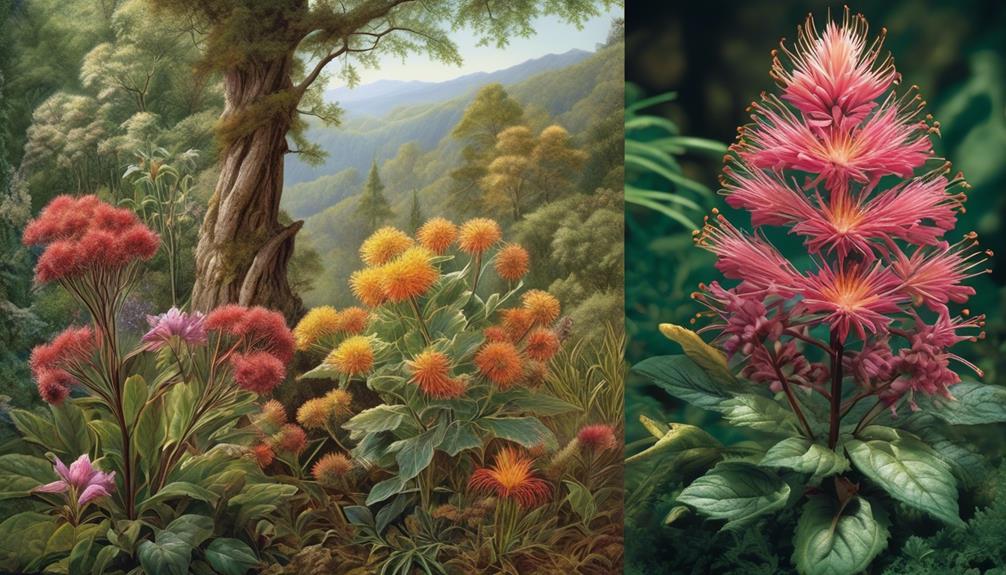Choosing between native plants and cultivars is like deciding between a timeless classic and a modern, carefully designed alternative.
The choice can greatly impact your garden's biodiversity, sustainability, and overall aesthetic.
Understanding the differences between native and nativar plants is crucial for making informed decisions about landscaping and conservation efforts.
As you explore this topic, you'll uncover the intricacies of each option and gain valuable insight into the delicate balance between tradition and innovation in horticulture.
Key Takeaways
- Native plants have evolved over thousands of years in specific regions, developing unique adaptations to the local environment, while nativars lack genetic diversity and resilience.
- Supporting a rich array of native plant species is crucial for maintaining biodiversity and ensuring vital ecosystem services.
- Cultivating native plants requires understanding their ecological requirements and growth habits, and market demand can support conservation efforts and incentivize their cultivation.
- Native plants offer a unique blend of beauty and ecological significance, thrive in their natural habitats, and provide food and shelter for native insects, birds, and other animals.
Origin and Adaptation
In understanding the distinction between native plants and nativars, it's essential to examine their respective origins and adaptations in order to appreciate their ecological significance.
Native plants have evolved over thousands of years in a specific region, developing unique adaptations to the local environment. These adaptations have enabled native plants to thrive in their natural habitats, demonstrating a remarkable resilience to environmental challenges such as extreme temperatures, drought, or soil conditions. Through the process of natural selection, native plants have become intricately intertwined with the local ecosystem, providing essential food and habitat for native wildlife.
On the other hand, nativars, which are cultivated varieties of native plants, often lack the genetic diversity and resilience of their native counterparts. While nativars may retain some characteristics of the original native species, they may also exhibit traits that make them less suited to the local environment. This can have significant environmental impacts, as nativars may not support the same biodiversity or provide the same level of ecosystem services as true native plants.
Understanding the origin and evolution of native plants and nativars is crucial for making informed choices about landscaping and conservation efforts.
Biodiversity and Ecosystem Support

Supporting a rich array of native plant species is crucial for maintaining biodiversity and ensuring the provision of vital ecosystem services. Biodiversity conservation is intrinsically linked to the presence of native plants, as they provide habitat and food sources for a wide range of native animal species. This intricate web of interactions contributes to ecological balance, ensuring that natural processes such as pollination, nutrient cycling, and pest control continue unhindered.
Native plants have evolved over time to fit into their specific ecological niches, forming complex relationships with other organisms in their native habitats. As a result, they play a fundamental role in supporting the overall health and resilience of ecosystems.
Their ability to thrive in their native environments also means they can be particularly effective in preventing soil erosion, filtering pollutants, and mitigating the impacts of climate change.
Cultivation and Availability
Cultivating native plants is essential to maintaining biodiversity and ecosystem services, and understanding their availability is crucial for conservation efforts. When it comes to cultivation techniques, it's important to consider the specific requirements of each native plant species. Market demand plays a significant role in determining which native plants are prioritized for cultivation, as high demand can drive increased production efforts.
Climate suitability is a crucial factor in determining the viability of cultivating native plants in specific regions. Understanding the regional availability of native plants is essential for conservation efforts, as it allows for targeted cultivation and restoration projects that can have a meaningful impact on local ecosystems.
- Cultivating native plants requires a deep understanding of their ecological requirements and growth habits.
- Meeting market demand for native plants can help support conservation efforts and incentivize their cultivation.
- Identifying regions where native plants are most climate-suited can guide cultivation efforts for maximum impact.
- Understanding the regional availability of native plants is essential for targeted conservation and restoration projects.
Understanding the cultivation and availability of native plants is crucial for effective conservation and restoration efforts.
Aesthetic Appeal and Characteristics

With a focus on the aesthetic appeal and distinctive characteristics, native plants offer a unique blend of beauty and ecological significance.
The aesthetic appeal of native plants lies in their ability to thrive in their natural habitats, offering a sense of authenticity and belonging to the environment. Their characteristics, such as diverse foliage shapes, colors, and textures, contribute to the visual interest of landscapes.
Additionally, native plants often have specific adaptations that make them valuable for wildlife, such as providing food and shelter for native insects, birds, and other animals. These characteristics add depth and intricacy to the ecological web, enhancing the overall appeal of native plantings.
Furthermore, native plants often exhibit resilience and low maintenance requirements, making them attractive options for sustainable landscaping. Their ability to withstand local environmental conditions, such as temperature extremes and soil types, contributes to their aesthetic appeal by ensuring long-term vibrancy and vitality.
Understanding these plant characteristics empowers you to create visually stunning landscapes that also support local ecosystems, making native plants a compelling choice for any gardening or landscaping enthusiast seeking beauty with ecological significance.
Considerations for Landscaping
After understanding the aesthetic appeal and ecological significance of native plants, it's essential to consider specific factors when incorporating them into landscaping designs. When integrating native plants into your landscape, consider the following:
- Water Conservation: Native plants are adapted to the local climate and require less water once established. By using native plants, you can significantly reduce your outdoor water usage, contributing to water conservation efforts and reducing your water bills.
- Soil Health: Native plants have evolved to thrive in the local soil conditions, which can help improve overall soil health. Their deep root systems also aid in preventing soil erosion and promoting better water infiltration, leading to healthier soil for your landscape.
- Wildlife Support: Native plants provide essential habitat and food sources for local wildlife, contributing to the biodiversity of your landscape. By incorporating native plants, you can create a balanced ecosystem that supports a variety of beneficial insects, birds, and other wildlife.
- Low Maintenance: Once established, native plants generally require less maintenance, such as fertilization and pest control, compared to non-native species. This can save you time and effort while promoting a sustainable, low-maintenance landscape.
Frequently Asked Questions
What Are the Potential Drawbacks of Using Nativars in Landscaping Compared to Native Plants?
When considering potential drawbacks of using nativars in landscaping compared to native plants, the environmental impact should be carefully evaluated. Conducting a cost benefit analysis is crucial, especially as gardening trends shift towards sustainability.
Nativars may offer aesthetic benefits, but their impact on local ecosystems and wildlife must be considered. Understanding the long-term consequences and balancing them against short-term gains is essential in making informed landscaping decisions.
How Do Nativars Impact the Local Wildlife and Ecosystem in Comparison to Native Plants?
Nativars can have a significant impact on local wildlife and the ecosystem compared to native plants. Research shows that nativars can disrupt the delicate balance of the ecosystem, affecting the availability of food and habitat for native wildlife. This disruption can lead to a decline in biodiversity and the overall health of the ecosystem.
Understanding the nativar impact on the ecosystem balance is crucial for making informed decisions in landscaping and conservation efforts.
Are There Any Specific Regulations or Guidelines for the Use of Nativars in Landscaping?
When it comes to landscaping with nativars, regulations and guidelines are essential for promoting biodiversity and conservation. These rules help ensure that nativars are used in a way that minimizes negative impacts on local ecosystems. By following established guidelines, landscaping with nativars can contribute positively to biodiversity and conservation efforts.
Regulations play a crucial role in balancing the benefits of using nativars in landscaping with the need to protect and preserve local wildlife and ecosystems.
Can Nativars Be Used to Restore or Enhance Natural Habitats in the Same Way as Native Plants?
Yes, nativars can have a significant impact on ecological restoration. They offer a wider range of traits than native plants, allowing for more precise restoration efforts.
However, it's crucial to carefully consider the genetic and ecological implications of using nativars in natural habitats. While they may enhance certain aspects of the environment, their use should be approached with caution to ensure they don't disrupt the balance of the ecosystem.
Are There Any Long-Term Environmental or Ecological Concerns Associated With the Widespread Use of Nativars in Landscaping?
In the long term, the widespread use of nativars in landscaping may raise concerns about their impact on biodiversity conservation and long-term sustainability. While they can offer aesthetic benefits, the potential ecological implications require careful consideration.
Striking a balance between the desire for diverse landscaping options and the preservation of native ecosystems is crucial for maintaining ecological resilience and biodiversity in the face of changing environmental conditions.
Conclusion
In conclusion, while some may argue that nativars offer more predictable characteristics and easier cultivation, it's important to consider the impact on biodiversity and ecosystem support.
Native plants have evolved to support local wildlife and contribute to a healthy ecosystem, making them a crucial choice for landscaping. By prioritizing native plants over nativars, we can preserve and promote the natural balance of our environment, ultimately benefiting both flora and fauna.
Mary is a passionate writer who brings creativity and a fresh perspective to our team. Her words have the power to captivate and inspire, making her an essential contributor to our content. Mary’s commitment to storytelling and dedication to promoting Indigenous culture ensures that her work touches the hearts of our readers. We’re fortunate to have her as part of our team.










